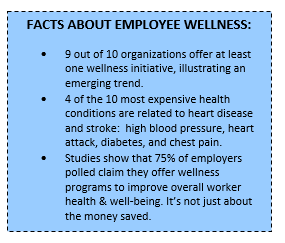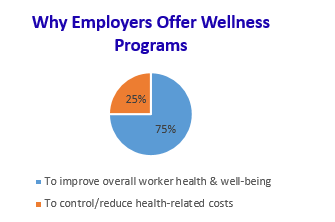
It’s widely known that work-related injuries and illnesses, chronic diseases, absenteeism, and sick employees who return to work before getting well negatively impact the bottom line of companies of all sizes. According to the CDC Foundation, these occurrences cost U.S. employers billions of dollars each year. With healthcare costs continuing to rise, employers have realized that improving employee health and wellness is an effective way to lower costs, improve productivity, and decrease absenteeism. By now, you may have realized the advantage of embedding wellness into your own workplace culture. If not, you may want to consider how you can promote good health and fitness among your employees, and the potential long-term benefits to both your company and your workforce.
year. With healthcare costs continuing to rise, employers have realized that improving employee health and wellness is an effective way to lower costs, improve productivity, and decrease absenteeism. By now, you may have realized the advantage of embedding wellness into your own workplace culture. If not, you may want to consider how you can promote good health and fitness among your employees, and the potential long-term benefits to both your company and your workforce.
What is Workplace Wellness?
The CDC (Centers for Disease Control and Prevention) defines a workplace health program as “a health promotion activity or organization-wide policy designed to support healthy behaviors and improve health outcomes while at work”. Wellness programs can focus on issues such as smoking cessation, diabetes management, weight management, and preventative health screenings, among many others.
Workplace wellness programs also embrace policies aimed at promoting employee health, including time allowances for exercise, providing on-site kitchens and eating areas, stocking the vending machines with healthy food options, and offering financial and other incentives for participation. Effective wellness programs and supportive policies are those that successfully motivate employees to not only care about their health but to actually take steps to maintain and/or improve it, which in the long run can positively impact employers, employees, their families, and communities at large.
Why Workplace Wellness?
Wellness programs sponsored by employers promote long-term employee health and reduce total insurance spending. These programs allow an employer to offer premium discounts, cash rewards, gym memberships, and other incentives to participate. Employers can provide a supportive environment to encourage their workers to adopt healthier lifestyles, which can in turn result in reduced claims, increased productivity, and fewer sick days. When employees commit to taking better care of themselves, they can benefit physically, emotionally, mentally, and financially. Health and wellness can have an impact on the bottom line of all concerned.
Rewarding the Positive
The 2016 Employer Health Benefits Survey conducted by the Kaiser Family Foundation states that 83% of large firms (200+ employees) offer
a wellness program that supports smoking cessation, weight management, or behavioral/lifestyle coaching. Forty-two percent of these large firms offer financial incentives for participation, such as lower premium contributions and cash to employees. Incentives are key to the success of a wellness program, and can be incorporated into the program by rewarding employees for attaining certain health-related goals, such as completing a health risk questionnaire or a biometric screening. Competition and one-on-one coaching are also common features of wellness programs. The PwC Health and Wellbeing Touchstone Survey from June 2016 shows that program participation increases when incentives are added to the mix. For example, when a health screening was offered with no incentive, participation was at 40%, as opposed to 57% when an incentive was involved.
Is it All Worthwhile?
In any business, employers are keen on seeing a return on their investments. With wellness programs, employers tend to see ROI in tangible ways, such as reduced absenteeism and a reduction in certain medical claims (e.g. urgent care visits instead of emergency room visits). An added benefit is that employers will often see an increase in the Value of Investment (VOI), indicated by increased loyalty, employee retention, and a boost in employee morale.
According to findings from the International Foundation of Employee Benefit Plans Workplace Wellness 2017 Survey Report, employers that offer and measure their wellness initiatives experienced increases in both ROI and VOI, with 92% of workplaces that offer wellness programs reporting their initiatives to be very or somewhat successful.
| Decreased Absenteeism | 50% |
| Financial Sustainability/Growth in the Organization | 63% |
| Increased Productivity | 66% |
| Increased Employee Satisfaction | 67% |
The IFEBP 2017 survey results also seem to indicate that responding employers are not primarily concerned with controlling or reducing health-related costs. In fact, the adjacent graphic illustrates that 75% of respondents were more concerned with improving overall health and well-being. Employers are increasingly realizing that wellness is more than just physical health. It also impacts the health of the organization, employee productivity, and overall happiness. Employees that feel empowered to take better care of themselves should experience less stress in their lives both on the job and off, creating happier, more productive employees.
increasingly realizing that wellness is more than just physical health. It also impacts the health of the organization, employee productivity, and overall happiness. Employees that feel empowered to take better care of themselves should experience less stress in their lives both on the job and off, creating happier, more productive employees.
It seems clear that wellness is “shaping up” to be a key area of investment and strategy for employers year after year. Creating a healthier work environment may be a critical piece of your organization’s success. Introducing wellness programs can show your employees that you are their partner, which is likely to be a win-win for both you and your workforce.
